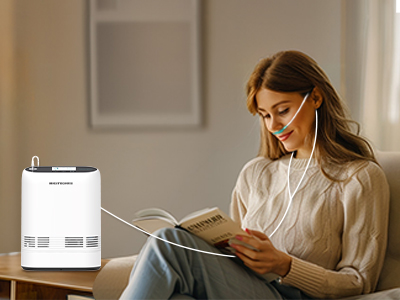06 Jan 2025
Oxygen is the lifeblood of the human body, silently fueling every organ and tissue. Without it, survival becomes impossible, and even a slight imbalance in oxygen levels can lead to serious health consequences. Measuring and maintaining appropriate oxygen levels is crucial for physiological harmony, yet many people overlook its importance. Understanding what constitutes a normal oxygen level is the first step toward ensuring optimal health and well-being.

What Are Oxygen Levels?
Oxygen levels refer to the amount of oxygen circulating in your blood, primarily bound to hemoglobin in red blood cells. This measurement, known as oxygen saturation, reflects how efficiently oxygen is being delivered to your body’s tissues. Typically expressed as a percentage, oxygen levels indicate the health of your respiratory and cardiovascular systems. They can be measured non-invasively with a pulse oximeter or invasively through arterial blood gas (ABG) testing.
Understanding Normal Oxygen Levels
For a healthy individual, oxygen saturation levels usually range between 95% and 100%. This means that nearly all hemoglobin molecules in the blood are saturated with oxygen. However, slight variations are normal and depend on factors such as age, altitude, and individual health conditions. Anything below 90% is generally considered a cause for concern, as it may indicate insufficient oxygen reaching the body’s vital organs. Maintaining normal oxygen levels is essential for cellular energy production, immune function, and overall vitality.
Methods of Measuring Oxygen Levels
The most widely used method for measuring oxygen levels is pulse oximetry. This non-invasive device clips onto a fingertip or earlobe, emitting light to estimate the percentage of oxygen in the blood. While convenient and painless, pulse oximetry is subject to minor inaccuracies due to factors like movement or poor circulation. For more precise measurements, arterial blood gas (ABG) testing is performed in clinical settings. This method directly measures the oxygen and carbon dioxide levels in the blood, offering a comprehensive analysis of respiratory function.
Variations in Oxygen Levels
Oxygen levels are not static; they naturally fluctuate throughout the day. Temporary dips in oxygen saturation may occur during activities like vigorous exercise, when the body demands more oxygen than usual. Conversely, oxygen levels can rise slightly during deep, relaxed breathing. External factors, such as altitude or air quality, can also influence oxygen saturation. For instance, at higher altitudes, oxygen levels in the air are reduced, which may temporarily lower blood oxygen levels. However, significant or persistent deviations from the normal range warrant further investigation.

Symptoms of Abnormal Oxygen Levels
Low oxygen levels, or hypoxemia, often manifest through symptoms such as shortness of breath, rapid heartbeat, fatigue, confusion, or a bluish tint to the skin and lips. If left untreated, hypoxemia can lead to severe complications, including organ damage and respiratory failure. On the other hand, excessively high oxygen levels, or hyperoxia, are less common but can occur in certain medical settings. Symptoms of hyperoxia may include dizziness, nausea, and in extreme cases, oxygen toxicity, which can damage the lungs.
Factors That Impact Oxygen Saturation
Several factors can influence oxygen levels, some of which are controllable while others are not. Chronic respiratory conditions, such as COPD or asthma, often reduce oxygen saturation by impairing lung function. Lifestyle choices, including smoking and physical inactivity, can exacerbate this issue. Environmental factors, such as high altitudes or exposure to polluted air, may also temporarily lower oxygen levels. Understanding these influences allows individuals to take proactive steps toward maintaining healthy oxygen saturation.
When to Seek Medical Attention
It is crucial to know when abnormal oxygen levels require medical intervention. Levels below 90% are considered dangerous and may lead to hypoxemia if not promptly addressed. Individuals experiencing symptoms like persistent shortness of breath, chest pain, or severe fatigue should seek immediate medical attention. Monitoring oxygen levels regularly, especially for those with underlying health conditions, ensures that any deviations are detected early. Timely intervention can prevent complications and support better health outcomes.
Tips for Maintaining Healthy Oxygen Levels
Maintaining healthy oxygen levels begins with adopting lifestyle habits that promote good respiratory function. Engaging in regular physical activity helps improve lung capacity and oxygen delivery. Avoiding smoking and minimizing exposure to air pollutants can also safeguard lung health. Staying hydrated and practicing deep breathing exercises enhance oxygen uptake, while proper posture ensures unobstructed airflow. For individuals with medical conditions, adhering to prescribed treatments, including oxygen therapy, is vital to maintaining optimal oxygen saturation.
Conclusion
Oxygen levels are a cornerstone of health, reflecting the efficiency of your body’s respiratory and circulatory systems. By recognizing the signs of abnormal oxygen levels and taking appropriate measures, individuals can safeguard their health and prevent potential complications. When in doubt, consulting a healthcare professional ensures the best course of action to maintain balance and vitality. Oxygen may be invisible, but its impact on life is profound.
Keywords: oxygen concentrator
Originally published 06 Jan 2025, updated 06 Jan 2025.